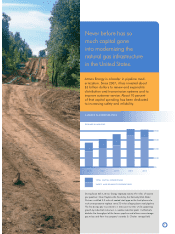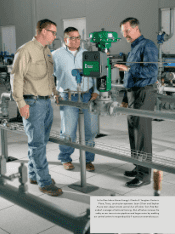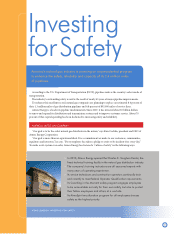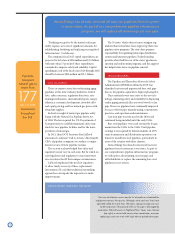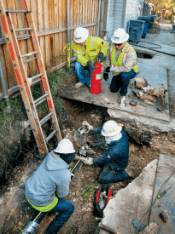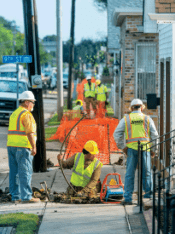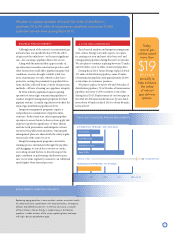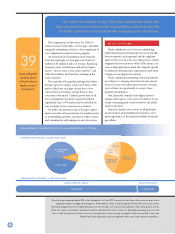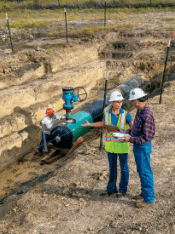Atmos Energy 2014 Annual Report Download - page 13
Download and view the complete annual report
Please find page 13 of the 2014 Atmos Energy annual report below. You can navigate through the pages in the report by either clicking on the pages listed below, or by using the keyword search tool below to find specific information within the annual report.
11
New or improved infrastructure reduces natural gas leaks, leading to
greater safety and reliability, and it lowers ongoing expenses charged to
customers for operation and maintenance.
ATMOS ENERGY: INVESTING FOR SAFETY
INNOVATIVE RATEMAKING
Many utility regulators recognize the need to
promptly, but eciently, replace aging pipelines
for greater safety as well as the enormous capital
demands that natural gas pipeline operators face.
Today most of the states where Atmos Energy op-
erates allow some form of accelerated rate treatment
for expenses that are outsized, volatile and generally
outside the utility’s control. Rate mechanisms, as
they are called, recover a wide variety of expenses.
Currently, 39 states allow rate mechanisms to
recover replacement costs for natural gas pipelines
and related infrastructure. at’s an increase from
only 11 states that permitted infrastructure improve-
ment mechanisms in 2007.
Infrastructure improvement programs, cost track-
ers, rate surcharges and deferral accounts specically
allow the recovery of infrastructure investment costs
as they occur. Annual formula ratemaking is more
general with recovery of infrastructure investments,
as well as other costs, between rate cases.
ese infrastructure mechanisms promote the
ecient recovery of the largest component in a
natural gas utility’s cost of service without pursuing
contentious rate cases. And, virtually any rate mech-
anism can be reviewed and adjusted in the utility’s
next led rate case.
As many public ocials have concluded, keeping
natural gas distributors nancially healthy is vital.
By allowing innovative rate treatment, regulators
balance their duty to treat utility investors fairly and
to ensure that customers receive safe, reliable and
economical service.
In 2013, the National Association of Regulatory
Utility Commissioners (NARUC) essentially ratied
this approach. NARUC passed a resolution “that
state commissions should explore, examine, and
consider adopting alternative rate recovery mecha-
nisms as necessary to accelerate the modernization,
replacement and expansion of the nation’s natural
gas pipeline systems.”
SUPPORTING SUSTAINABILITY
Regulators are approving alternative recovery mechanisms for natural
gas infrastructure to foster other public policies, too, such as environmental
improvement, energy eciency and economic development.
New or improved infrastructure reduces natural gas leaks, leading to
greater safety and reliability, and it lowers ongoing expenses charged to cus-
tomers for operation and maintenance.
Leaks reported by natural gas utilities to PHMSA have declined dramatical-
ly since 1991. Leaks on mains declined by 43 percent through 2010, and leaks
on service lines went down 50 percent by 2010.
From 2010 to 2013, Atmos Energy’s leak count fell by 43 percent, which
was three times better than the national average.
When assessing the eects on the environment, natural gas is far superior
to other fossil fuels. Electricity generated with natural gas is about 92 percent
ecient per British thermal unit (Btu), compared with 32 percent eciency
for coal-red generation. When comparing the total fuel cycle from wellhead
to burner tip, natural gas comes out far ahead on saving energy and doing
more work per unit of energy consumed.
Atmos Pipeline–Texas transports natural gas across the state of Texas primarily to serve our Mid-Tex Division and
other local distribution companies. With continuing economic growth in the state, APT is enhancing its capabilities
in the Waco-to-Austin corridor and other areas to assure high reliability to its customers and to connect new
sources of natural gas at competitive prices.
ATMOS PIPELINE–TEXAS
NATURAL GAS SUPPLY BASINS
REGULATED PIPELINE SPANS TEXAS
> 5,600 MILES OF INTRASTATE TRANSMISSION
> FIVE STORAGE FACILITIES WITH 46 BILLION
CUBIC FEET OF WORKING GAS CAPACITY
> TRANSPORTED 714 BCF IN FISCAL 2014
Haynesville/
Bossier Shale
Carthage
Hub
Katy Hub
Waha Hub
Eagle Ford
Shale
Barnett Shale
Granite Wash
Formation
Permian
Basin


